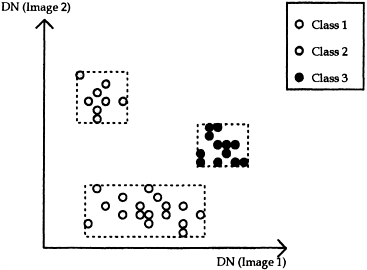308.
| [Cover] [Contents] [Index] |
Page 76

Figure 2.8 Each parallelepiped is bounded by minimal and maximal point values within the class.
2.3.4.2 Minimum distance classifier
Like the migrating mean clustering algorithm, the decision rule adopted by the minimum distance classifier to determine a pixel’s label is the minimum distance between the pixel and the class centres, measured either by the Euclidean distance or the Mahalanobis generalised distance (Equations 2.9 and 2.10). Both of these distance measures can be described as ‘dissimilarity coefficients’, in that the similarity between objects i and j increases as distance becomes smaller. The mean spectral vector, or class centroid, for each class (plus the variance-covariance parameters if the Mahalanobis distance measure is used in place of the Euclidean distance) is determined from training data sets. A pixel of unknown identity is labelled by computing the distance between the value of the unknown pixel and each class centroid in turn. The label of the closest centroid is then assigned to the pixel.
An example is shown in Figure 2.9, in which pixel a is allocated to class 1 (i.e. given the label ‘1’) according to the minimum distance between the pixel and class centre. The shape of each class depends on which distance function (Mahalanobis or Euclidean) is used.
This type of classifier is mathematically simple and computationally efficient, but the theoretical basis may not be as robust as that of the Maximum Likelihood classifier, which is described below. A comparison reported by Benediktsson et al. (1990) shows that, although the minimum distance classification using the Mahalanobis distance measure performs better than the same classifier using the Euclidean distance measure, its accuracy still falls considerably behind that achieved by the Maximum Likelihood algorithm.
| [Cover] [Contents] [Index] |
EAN: 2147483647
Pages: 354